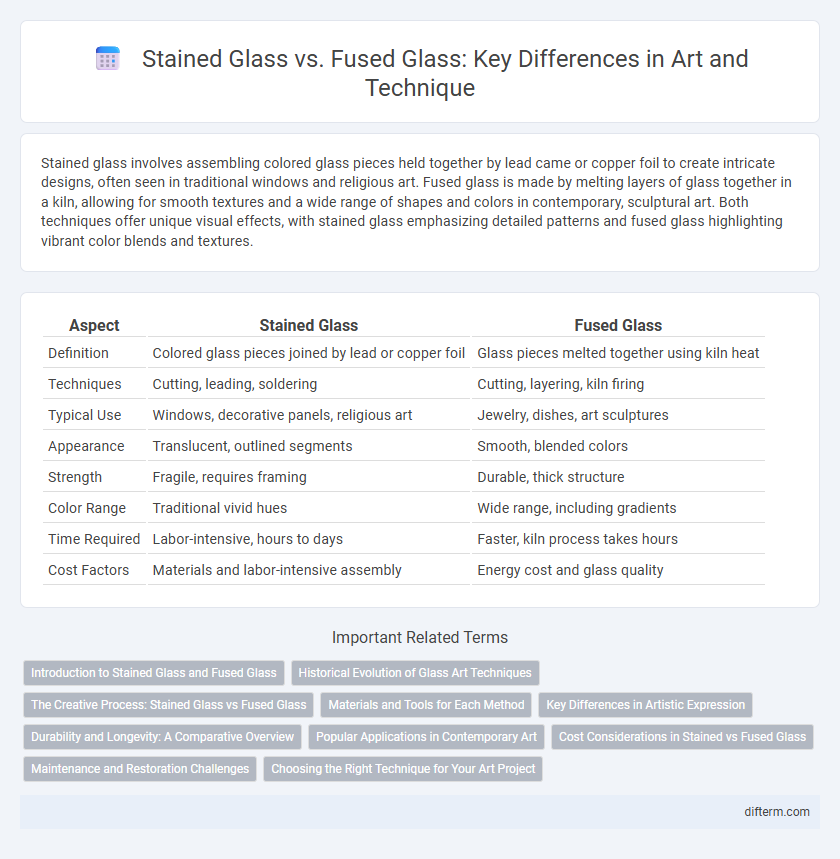Stained glass involves assembling colored glass pieces held together by lead came or copper foil to create intricate designs, often seen in traditional windows and religious art. Fused glass is made by melting layers of glass together in a kiln, allowing for smooth textures and a wide range of shapes and colors in contemporary, sculptural art. Both techniques offer unique visual effects, with stained glass emphasizing detailed patterns and fused glass highlighting vibrant color blends and textures.
Table of Comparison
| Aspect | Stained Glass | Fused Glass |
|---|---|---|
| Definition | Colored glass pieces joined by lead or copper foil | Glass pieces melted together using kiln heat |
| Techniques | Cutting, leading, soldering | Cutting, layering, kiln firing |
| Typical Use | Windows, decorative panels, religious art | Jewelry, dishes, art sculptures |
| Appearance | Translucent, outlined segments | Smooth, blended colors |
| Strength | Fragile, requires framing | Durable, thick structure |
| Color Range | Traditional vivid hues | Wide range, including gradients |
| Time Required | Labor-intensive, hours to days | Faster, kiln process takes hours |
| Cost Factors | Materials and labor-intensive assembly | Energy cost and glass quality |
Introduction to Stained Glass and Fused Glass
Stained glass is an ancient art form that involves assembling colored glass pieces held together by lead came or copper foil, primarily used in windows and decorative panels. Fused glass is created by layering glass pieces and melting them together in a kiln, allowing for more intricate designs and varied textures. Both techniques showcase vibrant color and light interaction but differ significantly in process, durability, and artistic flexibility.
Historical Evolution of Glass Art Techniques
Stained glass originated in medieval Europe, flourishing in Gothic cathedrals where artisans used colored glass pieces joined by lead to depict religious narratives with vibrant light effects. Fused glass, emerging in the 20th century, involves melting multiple glass layers in a kiln to create intricate, smooth designs, reflecting advancements in kiln technology and modern artistic experimentation. This historical evolution underscores a shift from structural, narrative-focused stained glass to more abstract, versatile fused glass techniques.
The Creative Process: Stained Glass vs Fused Glass
Stained glass involves cutting colored glass into precise shapes and assembling them with lead came or copper foil, emphasizing meticulous design and manual labor. Fused glass requires layering glass pieces and melting them in a kiln to create seamless compositions, offering more fluidity and experimentation with textures and colors. Both methods demand distinct technical skills, with stained glass prioritizing precise assembly and fused glass focusing on controlled heat transformation.
Materials and Tools for Each Method
Stained glass art uses sheets of colored glass cut into shapes and joined with lead came or copper foil, requiring tools like glass cutters, grozing pliers, and soldering irons. Fused glass involves layering glass pieces fused together in a kiln, demanding materials such as compatible glass types and tools like kilns and glass rollers. Understanding the unique materials and tools for each technique is essential for achieving precise design and durability in glass artwork.
Key Differences in Artistic Expression
Stained glass art relies on assembling colored glass pieces held by lead came or copper foil, emphasizing intricate line work and traditional craftsmanship. Fused glass involves melting glass sheets or powders in a kiln, allowing for smooth, seamless color blending and sculptural effects. The key artistic difference lies in stained glass's linear composition versus fused glass's fluid, textural possibilities.
Durability and Longevity: A Comparative Overview
Stained glass, crafted by assembling colored glass pieces held by lead cames, offers exceptional durability with a lifespan often exceeding several centuries when properly maintained. Fused glass, created by melting glass pieces together in a kiln, provides strong structural integrity but generally has a shorter lifespan due to greater susceptibility to thermal stress and environmental wear. Both mediums require protective treatments to enhance longevity, yet stained glass remains superior in enduring exposure to weather and aging.
Popular Applications in Contemporary Art
Stained glass is widely used in architectural installations, church windows, and decorative panels, valued for its vivid colors and intricate designs that transform light into artistic expression. Fused glass finds popularity in contemporary sculpture, jewelry, and functional objects like bowls and plates, prized for its versatility in layering colors and textures through kiln firing. Both mediums serve as dynamic tools in modern art, blending traditional craftsmanship with innovative techniques to create visually striking pieces.
Cost Considerations in Stained vs Fused Glass
Stained glass typically involves higher material and labor costs due to the complexity of cutting and assembling individual colored glass pieces with lead came or copper foil. Fused glass offers a more cost-effective alternative, as it uses kiln-firing techniques to bond glass layers, reducing assembly time and labor expenses. Budget-conscious artists must weigh the long-term investment in tools and materials for stained glass against the relatively lower initial costs and equipment needed for fused glass creation.
Maintenance and Restoration Challenges
Stained glass requires delicate cleaning to preserve its lead cames and intricate painted details, often necessitating professional restoration to address weather-induced deterioration. Fused glass, typically thicker and more resilient, demands less frequent maintenance but poses challenges in repairing cracks or chips without compromising the fused layers. Both mediums require specialized techniques to maintain structural integrity and aesthetic quality over time.
Choosing the Right Technique for Your Art Project
Choosing between stained glass and fused glass depends on the desired aesthetic and technical requirements of your art project. Stained glass offers intricate, traditional designs with vibrant color separations created by lead came or copper foil, ideal for windows and panels. Fused glass involves melting multiple glass pieces together in a kiln, allowing for smooth gradients and contemporary textures best suited for decorative objects and jewelry.
stained glass vs fused glass Infographic

 difterm.com
difterm.com